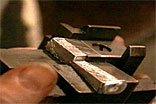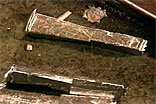Here’s a translation, which I have to say does more to illustrate the short comings of mechanical translation engines [in this case: Babel Fish - eat your heart out Douglas] than explain what’s going on:

Oskar Bernhard is one of the last Schriftsetzer in Germany. He works in Noerdlingen in one approximately 400 years old house directly on the medieval stadtmauer. Still today it has orders, which reach from the birth announcement over the bill of fare up to the small book. In contrast to the standardized large-scale enterprise it makes its customers of suggestions, which character font, which size or color could have the writing.

Measure the height of pictures
Out in lead the schriftsetzer builds up poured letter, which the writing caster manufactures, a text, which to him an author submitted. The letters, which it uses, have an exactly standardized height. That is later important for a constant pressure in the printing machine. Also pictures or decoration components of the side must keep this height. Sometimes it concerns hundredth millimeters. So that the height is correct, the non--text components are measured individually, before they are built into the side and supported if necessary.

A metal lead mixture is poured into a form.

If the form is removed, the letter remains.

The letters must have accurately the same height.
The schriftsetzer determines the size of the writing in the unit "point". The expression "point details work" comes along. From a setting box, which weighs approximately 20 Kilos, the typesetter takes the lead letters and puts her one behind the other into a "winkelhaken" - mirror-operates and standing on the head. At the end of a line the line is fixed: In addition the schriftsetzer blind material takes, Spatien so mentioned. With them it varies the gap between the words so for a long time, until an even line developed. The line must hold with the pressure of the Spatien at the end automatically in the winkelhaken. Thus line follows after line, until a paragraph is finished. From even bringing in of the Spatien the impression of a text block results, to the grouped style.
Katrin lives in Bavaria, near to where this printing business all began.
3 comments:
It sort of makes sense if you compare the original with the translation, even though my German is very limited! Good that there are still people doing it the old-fashioned way. I hope that the Holmfirth Museum of Typography will be able to preserve these skills.
it wasn't a rude comment or anything objectionable, simply that Daphne posted her comment twice.
Post a Comment